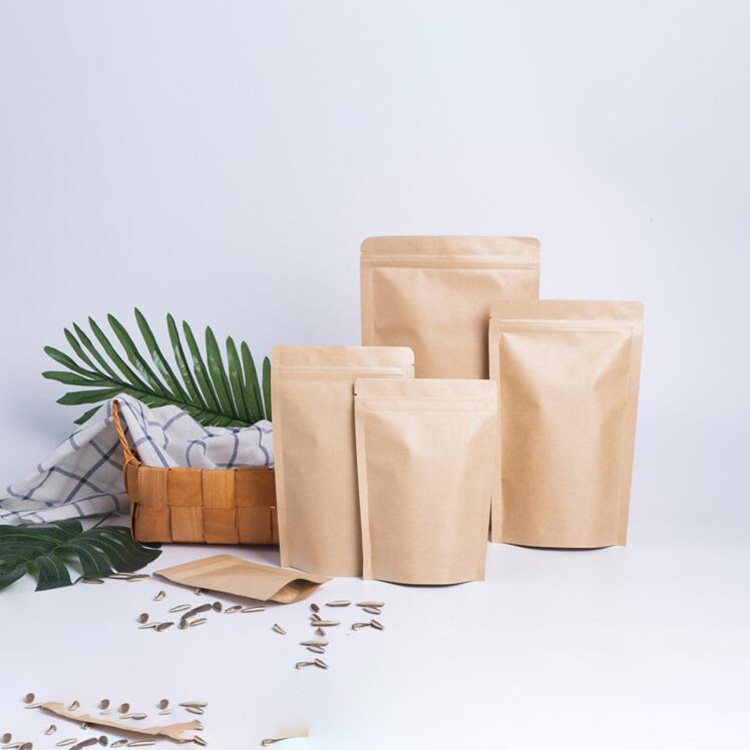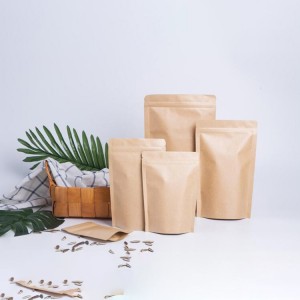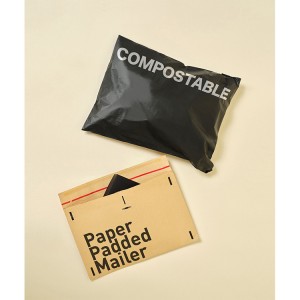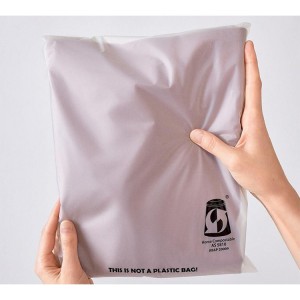
100% Compostable Stand Up Bags Made by PLA and Paper
Compostable—PLA-Biodegradable
This is the newest structure that has hit the printed stand up pouch market. As I described above regarding paper itself, this material uses a kraft paper base and then is coated/laminated with a PLA material that provides some barrier properties and allows the entire bag to biodegrade when exposed to air and sunlight. There are problems with this material and design. Some countries overseas are NOT happy with PLA coatings and materials because of the out-gas that comes when it is exposed to air and sunlight.
Some countries have BANNED PLA coated products completely.However, in the US, printed stand up pouches with a PLA coating are accepted (for now). Issues are that these bags are not very strong or durable, so they don’t do well with heavier loads (over 1 pound) and the print quality is average at best. Many companies who want to use this type of substrate and have an attractive print scheme often start with a white kraft paper so the printed colors look more appealing.
PROBLEMS AHEAD
• Keep this in mind, when using laminated materials that are of the same "family"...clear film and metalized or foil...they all play well together and can recycled in landfills and most often have a recycle symbol of an R7. When paper is involved...like regular kraft paper or even compostable paper...these items cannot be recycled together...at all.
• Dirty little secret...everyone wants to help the environment. However, in the US, when our garbage goes to the recycler no one can tell if the film is laminated with other materials (making the recycling an R7) or a pure recyclable material...like the blue shopping bags we get from the grocery store. If there was a controlled system to identify whether a film is laminated or not...or what the materials are in the laminated film, the recycling company could easily identify and group the materials accordingly. ..there is NOT...so ALL plastic that goes to a recycler (unless in a controlled system that only recycles a certain type of plastic film…very, very rare)...ALL plastic is ground back up and considered an R7 or regrind.
• Dirty little secret 2...when we send our garbage to the landfill...garbage stinks...it smells. Because garbage smells, the first thing the landfill does when garbage gets there is to bury the garbage to control and eliminate the odor. Once garbage...of ANY kind is buried...nothing is exposed to air or sunlight....so nothing can biodegrade...The point, you could have the most elaborate eco-friendly material but if it cannot be exposed to air or sunlight, nothing will biodegrade.
• Understand The Terminology of Eco Friendly
• Eco Friendly, Biodegradable, Recyclable, Sustainable
Terms:
• Eco Friendly: refers to the effort to use materials and structures that take into account how they will react to the environment and even how we will dispose of them (can they be reused, recycled, repurposed, etc)
• Biodegradable – Compostable: refers to material structures that are made from or have a coating/lamination of different ingredients that react to air and sunlight that accelerate how a package breaks down when it is no longer in use. Requires air and sunlight to work
• Recyclable—refers to if packaging can be grouped with other "like" packaging and either ground back up and made into the same or similar material again, or ground back up to be used in the making of other products. Requires a structured plan to recycle either ALL the same structures (a type of film for example) or to recycle SIMILAR structures. This is a major difference. Think of recycling all of the same grocery bags from the checkout…the thin blue or white bags for groceries. This would be an example of recycling all of the same film structure. This is very difficult to do and control. The other approach is to accept ALL plastic materials up to a certain thickness (like the blue grocery bags and all bags used for packaging coffee beans for example). The key is to accept all similar materials (not the same) and then all of these films are ground up and used as "filler" or "base materials" for children's toys, plastic lumber, park benches, bumpers, etc. This is another way to recycle.
• Sustainable: an overlooked but highly effective way to help our environment. If we can find ways to improve our business by reducing how much energy is used to create the packaging or ship it or store it or all of the above, these are examples of sustainable solutions. Taking a rigid plastic container that holds windshield washer fluid or cleaning supplies and using a much thinner, flexible package that still holds the same amount but uses 75% less plastic, stores flat, ships flat, etc…is a classic example. There are sustainable options and solutions all around us if you only look.














